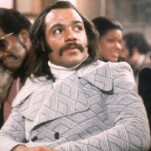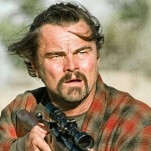The New Cult Canon: Irma Vep
"It is visually beautiful, but the editing is so
self-destructive that it's as if Hopper had slashed his own canvases."
—Pauline Kael on Dennis Hopper's The Last Movie
After reading the quote above many years ago, I
felt I had to see Dennis Hopper's The Last Movie immediately—not
because it might be visually beautiful, but because I was excited to see an
artist slash his own canvases. What possible impulse could lead a filmmaker to
sabotage his own work? And what does a film wind up looking like when it's
completely torn apart and we can see the pieces of a more conventionally
"cohesive" work lying on the floor? It's a very punk-rock thing to do, but it's
also what film critics do by trade—pick apart and examine all the
individual pieces that go into the whole, and occasionally slash a few canvases
when necessary.
Turns out I couldn't really abide The Last
Movie—which
was more just a mess than the purposeful mess I was hoping for—but in
1996, Olivier Assayas' Irma Vep brought out the knife and happily slashed away.
In that respect and many others, the film is a true torchbearer of the French
New Wave—playful, restless, full of invention, and born of an
overwhelming discontent for the status quo. At a time of artistic crisis, when
French cinema was in danger of losing its identity to popular American imports,
Assayas issued Irma Vep as a wake-up call to an industry that was slipping into
compromise and irrelevance. Much like our Graham Greene-inspired friend Donnie
Darko, when he floods the school and burns Patrick Swayze's house down, Assayas
performed an act of creation by destruction. He also made film criticism seem
sexy—which, as one of the pasty-faced legions who make a living from it,
I can respect as no mean feat.
At the center of the movie—and a movie this
scatterbrained needs a strong center—is Maggie Cheung, one of the world's
most glamorous stars, playing herself. (Assayas later married her, temporarily
cementing his status as the world's hippest film director. They divorced three
years later, but it was amicable enough for Assayas to cast her as a Courtney
Love/Yoko Ono type in 2004's Clean.) When we first see Cheung, she's stepped into
the middle of a French production office and nobody seems to notice, which is
just the first sign of how terminally chaotic the industry has become. No one
picked her up at the airport and no one seems to even expect her, even though she's
been chosen to play the lead role in a production slated to shoot imminently.
She tries to apologize for being three weeks late, due to overruns on her
latest Hong Kong film, but who would know to accept her apology?
Cheung has been cast as the lead in a remake of Les Vampires, Louis Feuillade's
landmark 10-part serial from 1915 about a devious villainess who leads an
underground thieving operation called The Vampire Gang, and steals jewels while
wearing a form-fitting black catsuit. To most, it's a baffling choice to cast a
Chinese actress in a role so quintessentially Parisian, but then again, there's
nothing that looks wrong about Maggie Cheung in a latex catsuit. The director,
René Vidal, is well past his prime; and since he's played by Jean-Pierre Léaud—the
legendary Antoine Doinel from François Truffaut classics like The 400 Blows and Stolen Kisses—we can probably
assume that he's a creatively stilted New Wave holdover. Whatever the case, René
can't really come up with a coherent reason for remaking Les Vampires, but he tells Maggie that
he saw her martial-arts film The Heroic Trio in Marrakech, and he
hired her because she looked like a dancer. (Poor Maggie then has to give Réne
the bum news that all those action sequences were really done by stunt
doubles.)
And so it goes. Shooting doesn't go well. The one
scene we do see get filmed in the movie-within-a-movie gets ruined by the
actors cracking up… for the 24th take in a row. Réne storms out of dailies,
raging about how his movie is "shit," and has a nervous breakdown. Meanwhile,
wardrobe assistant Zoé, played with winning hyperactive charm by Nathalie
Richard, develops a crush on Maggie, who doesn't pick up on her advances. Both
Réne and Zoé project their fantasies onto her—and who can blame
them?—but Maggie doesn't fit comfortably into the roles they want to her
to play. If there's one word to describe Maggie's odyssey in France, it's awkward: Having to deal with the
language barrier is one thing (she speaks English, but no French) and feeling
alienated in a foreign land is another, but more than that, she's thrown in the
middle of other people's crippling dysfunction. It's a wonder she doesn't catch
the next flight out of De Gaulle at any moment.
There are innumerable great touches, big and
small, in Irma Vep,
which is organic and alive like few movies ever are. (It was shot on the fly in
three weeks, and the spontaneity shows.) But the one sequence that everyone
who's seen the film remembers is a restless Maggie slipping into her catsuit
after hours and skulking around the hotel like Irma Vep in the movie. Only this
time, she embodies the role effortlessly—she's sexy, mysterious,
resourceful, and liberated in a way that she couldn't have been in Réne's
stale, pointless remake. Here's the beginning of the sequence, set to Sonic
Youth's "Tunic (Song For Karen)." (Assayas employed Sonic Youth again six years
later to do the music for Demonlover, another potential NCC entry.)








































